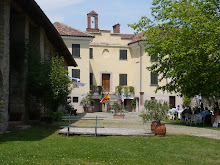
Oggi ho intervistato Giorgio, il fratello n° 5 , per sapere come stanno andando le cose in vigna...
Nonostante il tempo che quest'anno ci ha “regalato” abbondanti nevicate e un gran numero di giornate gelide ( stanno tornando gli inverni di una volta...altro che effetto serra) abbiamo ultimato la potatura. A tempo di record, bravissimi i nostri potatori che non si sono fermati quasi mai !

La potatura invernale è una pratica di fondamentale importanza per la corretta gestione del vigneto, poiché consente di ottenere viti equilibrate e in grado di garantire una resa corretta e soprattutto un'ottima qualità dell'uva.
E' sicuramente la lavorazione più importante e difficile dell'anno e quando si esegue bisogna tenere conto sia della fertilità del terreno che della vigoria delle piante.
Il sistema di potatura da noi adottato è il guyot semplice. Con questo metodo si tende a lasciare un solo tralcio vecchio con mediamente 6/8 gemme e un piccolo sperone con 2/3 gemme per l'anno a venire.

Detta così sembra molto semplice, ma tutt'altro...spesso bisogna fermarsi con attenzione presso ogni pianta per valutare i comportamenti passati e gli eventuali problemi presenti, quale tralcio scegliere e quante gemme lasciare .Richiede senza dubbio molta esperienza ed abilità...so per certo che queste qualità non mancano e in vendemmia ne ho la conferma tutte le volte che osservo i grappoli...
Finished the pruning winter ... in record time
Today I interviewed George, brother No. 5, to see how things are going in the vineyard ...
Despite this year the weather has "given" heavy snowfall and a large number of cold days (the winters are returning to a past times ... other than greenhouse effect ), we finished the pruning. In record time! Very good our pruners that did never stop!
Winter pruning is a practice essential for the right management of the vineyard, because it can get balanced vines and able to ensure a correct yeld and especially an excellent quality of the grapes.
It is the most important and difficult handwork of the year: to be necessary to take both the fertility of the land and the vigor of the plants.
The pruning system we adopted is simple Guyot. This method tends to leave only one old vine branch with 6 / 8 buds and a small branch with 2 / 3 buds for the next year . That seems so very simple, but on the contrary! ... often to be necessary to examine each plant carefully and to consider the past and actual problems, which branch to choose and how many buds to leave. It requires no doubt a lot of experience and skill ... I know for certain that these qualities are not lacking , I have confirmed in vintage time ,when I look at the grapes ...



